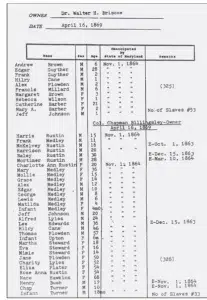Hilry Kane
A Cornerstone of Sotterley’s Descendants Project
Hilry Kane (Cane) faced chattel slavery, the Civil War, emancipation, reconstruction, finally established an independent life. Through him, we can understand what life was like for an African American in the 19th century.
(1818-1889)

Hilry Kane was born into slavery in 1818 in St. Mary’s County. Hilry’s parents, Raphael Kane and Clara, were enslaved by different owners. Hilry lived with his mother on the plantation owned by William Neale of Jeremiah until his mother was sold to another plantation. At that time in 1827, Hilry was transferred to James J. Gough to settle a debt.
While with Gough, Hilry learned the craft of plastering and farming skills. In 1847, Hilry married another who was enslaved on the plantation, fourteen-year-old Mariah, and together they had seven children. When Gough died in 1848, his will dictated that the family be divided among his seven children. Gough’s estate was liquidated and Hilry, Mariah, and their children were put on the slave auction block in Leonardtown. Hilry was sold to Colonel Chapman Billingsly for $600 and Mariah and their children were sold to Dr. Walter Hanson Stone Briscoe.
Briscoe’s Sotterley Plantation, was situated next to the Chapman Billingsly plantation, and Hilry was permitted to live with his family at Sotterley. Mariah died shortly after arriving at Sotterley and Hilry married fifteen-year-old Alice Elisa Bond. Together, they had thirteen children who were all born in a small cabin in the slave quarter at Sotterley.
Hilry had many skills and talents. Colonel Billingsly often hired Hilry out for plastering jobs. Oral tradition relates that Hilry plastered many of the finest homes in St. Mary’s County. When he was with his family, Hilry made furniture and musical instruments, including a banjo that he could play. Hilry was considered the “doctor” for the enslaved as well and utilized his knowledge of medicinal herbs to treat a variety of conditions.
Hilry obtained his freedom at age 46 in 1864, following the abolition of slavery in Maryland on November 1, 1864. After emancipation, Hilry chose to stay at Sotterley and work as a tenant farmer. He officially left Sotterley in 1879 to settle with Elisa in their own home in Hollywood. Hilry died in 1889.
Hilry Kane lived through multiple pivotal and tumultuous moments in United States history in his near 71 years of life. After facing chattel slavery, the Civil War, emancipation, and reconstruction, Hilry autonomously established his life in Hollywood, Maryland. Hilry’s legacy lives on through the work of his descendants including Agnes Kane Callum.
Additional Resources
“A Guide to the History of Slavery in Maryland, Historic Sotterley Plantation and the Kane Family pages 19-21 http://mdslavery.net
Sotterley Plantation | back2past
Chapter Four Sotterley – “Equals at Last” Copyright, 2015, by Samuel C.P. Baldwin, Jr. equals-at-last-1.pdf (baldwinbriscoe.com)
Historic Sotterley Home – Sotterley
The Evening Sun, Baltimore, MD, Tuesday, July 10, 1990, Page 4
